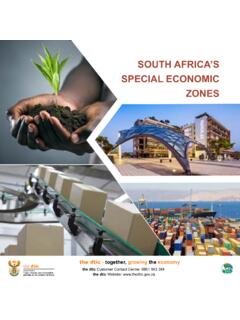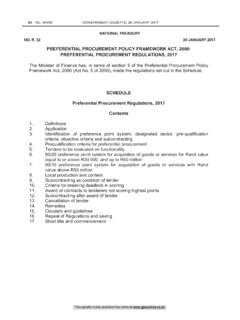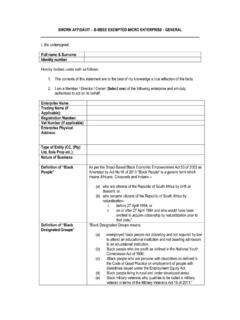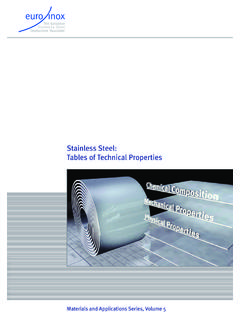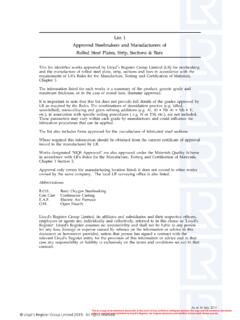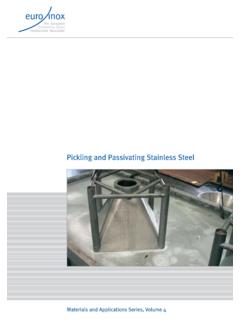Transcription of The South African Steel and Metal Fabrication Master Plan 1
1 Towards full-scale industrialisation and inclusive growththe dtic Customer Contact Centre: 0861 843 384 Website: South African Steel and Metal Fabrication Master Plan FOR THE Steel VALUE CHAINNameDesigNatioNsigNatureebrahim Patel MinisterDepartment of Trade, Industry and Competitionirvin Jim General SecretaryNumsamarius Croukamp Deputy General SecretarySolidarityKobus Verster CEO arcelor mittal SASupply-sideFreddy mugeri CEO Fabchem MiningDemand-sideelias monage CEO Afika PowerAfrican Continental Free Trade Area AgreementJohan strydom CEO Columbus stainless SteelResource MobilisationNonhlanhla Ngwenya MD MphoNo EnergiesHuman Resourcestumi tsehlo Ceo Dynamic Fluid ControlTransformation Portia Derby Group CEOT ransnet SUPPORT FOR THE Steel MASTERPLANThe following government.
2 Industry and labour representatives commit as workstream leads to work with all social partners towards the Master Plan outcomes STATUS OF THE DOCUMENTThis document consolidates the comments received from the Steel and Steel products industry and stakeholders in government on the first draft of the Steel Master Plan. The first draft, which was circulated for comment on 6 October 2020, was the outcome of discussions held between industry stakeholders and government facilitators. This document incorporates feedback received from industry and specific public entities. The Minister convened the first Steel Oversight Council to table this revised document and consider an implementation Implementation Plan covers the immediate priorities from the base document, setting out the areas of focus within the first six months, the first year, and the first three Master Plan will guide the stabilization and progress of the industry.
3 It is a dynamic document, hence it is called version , and it is expected that changes will be made when necessary following discussion at the Steel Oversight Council. Such changes will aim to take account of the developments in the industry, including internal and the external factors which affect the South African Steel and Metal Fabrication Master Plan INTRODUCTION TO THE Steel Master PLANThis Master Plan has been prepared to support and anchor the implementation of the Re-imagined Industry Strategy and the Reconstruction and Recovery Plan launched by the President in October 2020. A large number of interactions have taken place with the industry, including both employers and unions, with economists and researchers, State-Owned Enterprises and many others.
4 There is a large amount of research backing the Master Plan, but it is not included in this document. The Master Plan seeks solutions rather than reiterating the well-known problems. This Master Plan builds on the excellent work and proposed measures by the Steel Task Team in 2016, but sets out mechanisms to accelerate and make the previous measures more effective to achieve the desired impact. The key thrust is of this Master Plan is collaborative effort between the social partners, focused on fast-tracking implementation and assisting government institutions to be more agile and designing the Plan, it was therefore important to bring all key stakeholders to build consensus on a policy that can drive towards a competitive, dynamic and inclusive industry and which is able to provide a stable platform for investment, growth and job creation.
5 Therefore, a dual process has been adopted, to finalise and sign-off on the Master Plan and its future iterations while continuing to sharpen the implementation of the on-going support measures afforded to the industry, set out elsewhere in the WHY THE Steel Master PLAN Steel Master Plan represents a consolidation of feedback from the industry, labour and regulators. Gaps identified in the initial draft have been addressed. Government is mindful of the need to build a broad consensus on measures to rebuild the entire value chain, which is highly fragmented, has many sectorally-distinct interests, and could therefore take some time to rebuild. In view of the need to move with speed, the approach adopted is to have this Master Plan in place (hence the name, Steel Master Plan ) and to continually review, adapt and adjust based on the experience gleaned from implementation.
6 Smaller changes may result in new iterations of the Plan ( Steel Master Plan ), while major changes may with time require significant resets of targets or level of ambition as the industry develops and conditions change, resulting in a Steel Master Plan Note, however, that the Steel Master Plan is already intended to establish a stable and predictable trajectory for the industry, so that businesses and investors can invest with confidence in building up production capacity, innovation, skills and expertise. The Steel Master Plan is not intended to be principally a detailed analysis document of the state of the industry. It is rather a focused set of practical steps which must be implemented on a consistent basis.
7 The emphasis in the Master Plan is therefore on concrete commitments by each of the major stakeholders: investors/manufacturers throughout the different Steel and engineering value-chains; organized labour; supplier and customer industries; and public sector entities. As implementation takes place, adjustments will be considered, based on experience. Constituencies are requested to identify additional commitments they are able to make. In particular, the current version of the Steel Master Plan requires firmer and clearer undertakings by firms, investors and organised labour. The commitments by government and public entities will depend on a balanced package of measures in which each social partner brings additional resources to the Plan, in order to change the direction of the industry.
8 Commitments will be included in the implementation plan, with specific dates and resource commitments. More detailed sub-sector actions will also be developed during this second phase. BROAD CONSENSUS ON THE NUANCE AND DIRECTION OF PLANT here is common agreement that that the recovery and growth of the industry requires long-term thinking. The industry is now in survival mode and so focuses on cost cutting. Urgent measures are required to give the industry a breathing space and to ensure its survival. Although the industry is in crisis, there is investment taking place. It is the view of a number of investors that because of the significant excess capacity in both the upstream and downstream industries, the investment is limited and is like to continue to be muted until demand increases and there is consolidation in the industry.
9 Most of the investment appears to be taking place in two areas: production of primary Steel products (including direct reduction iron and pig iron) and downstream processing to replace higher value-added imports, particularly in the wire industry. It appears that family-owned or privately-held companies are more inclined to invest at this time than those which are owned by institutional investors, which tend to have a short-term view. 3 The South African Steel and Metal Fabrication Master Plan , steelmaking and the downstream production of value-added products from Steel are not short-term activities: they require long-term investment and some predictability for the industry. The decision to break up Iscor was based on short-term thinking: integrated production of Steel is essential for its viability and it is not unreasonable to hope that the suppliers of ore, coal and other inputs would be receptive to participating in integrated Steel production.
10 Revitalizing investments in the industry must be based on long-term objectives and take into account the environmental considerations and the imminent need to green production processes. The goal of production of green Steel by 2050, based perhaps on the hydrogen economy, should be adopted by government and the industry. Funding for the green economy is available on favourable terms and should be seen as a key component of the way forward for the Steel industry. This will apply equally to foundries and smelters, who will increasingly come under pressure from their customers (such as the international auto industry OEMs) to be green. Long-term objectives are essential to transform the industry too. Helping Black investors to buy into failing companies which require large capital injections to turn them around is not attractive in a market which is not growing.
